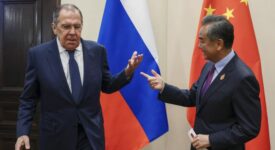European and Asian allies of the United States are increasingly under pressure from Russia and China. In both regions, small and middle powers face a revisionist and assertive nuclear-armed military power in possession of regional power projection capabilities. Russia and China are highly motivated to establish and protect regional spheres of influence using a broad assortment of state instruments of influence both above and below the threshold of war. At the same time, there are also clear differences between the challenges that East Asia and Europe confront: European security problems are primarily land-based, while those in East Asia are primarily maritime.
In NATO Europe, the possibility of territorial losses through ‘salami-slicing’ and faits accomplis, including against NATO members, remains significant. In military terms, Russia enjoys local conventional preponderance relative to the Baltic states and Poland. NATO is dependent on reinforcements to arrive rapidly to contested areas.Yet,Europe has a strongly institutionalized alliance system. It should be noted that NATO’s security guarantees do not extend to non-NATO members. States such as Ukraine are therefore vulnerable to Russian aggression, as once again demonstrated by Russia’s military encirclement of Ukraine in late 2021 and early 2022. Aggression against non-NATO members cannot and does not reflect on the Alliance deterrence posture itself, though it does constitute a risk to the overall stability in the region.
In Asia, while China threatens states around the South China Sea, especially Taiwan, it would be difficult to fundamentally change the territorial status quo without large-scale amphibious warfare. Yet, China has developed anti-access / area denial (A2/AD) capabilities to drastically raise the costs for the US to intervene and protect allies and partners in the region. The logistical infrastructure that would enable effective defense and deterrence by denial of these states is under pressure due to the military infrastructure in range of potential attacks, as well as the vulnerability of the lines of communication between these points. Nor is there an institutionalized system of alliances in East Asia or the Asia-Pacific that can address temporary shortfalls in US capabilities. Russia and China, moreover, possess unique strategic cultures, are clearly trending in opposite directions in terms of national power, and have distinct military modi operandi.
By breaking down the deterrence problems in both the European and the Asian theater according to the 5Cs of clarity, capabilities, criticality, commitment, and cohesion, we can disentangle the challenges and point to possible solutions. The variations in strengths and weaknesses point to the need for an integrated approach, however faddish the term might be.
The challenges that the US and its allies encounter in the European and Asia-Pacific theater are similar. In both theaters, while arguably at a regional and certainly at a global disadvantage, Russia and China can exploit local imbalances in capabilities against the Baltic states and Taiwan specifically. Given the land-based context in Europe, Russia might achieve a fait accompli which it could then exploit through nuclear threats and its A2/AD capabilities. A fait accompli would be very difficult in the Taiwan scenario due to the difficulties of amphibious operations and the narrow battle space that China’s forces would or could be forced through. However, China could provoke the US to respond and then make a US intervention costly and slow through its A2/AD capabilities. Limited numbers of pre-positioned forces, limited military mobility, and the geographic distance between the US and the potential theater of war act as serious constraints. Russia and China’s hybrid activities are arguably under-appreciated. Both states could accomplish a great deal of groundwork by dividing and slowing down responses by regional states and the US.
There is no silver bullet to these shortfalls in either theater. Solely focusing on improving military mobility and improving access to the theater of war, or simply upping military expenditures might not only be financially unsustainable but possibly counterproductive, unless they are targeted at solving specific conventional military problems. It can heighten the risk of escalation, encourage adversaries to increasingly resort to hybrid aggressions, and aggravate disunity within the existing alliance structures over responsibilities and interests.
Therefore, in both cases, the deterrence postures can only be strengthened by addressing their shortfalls in a coherent and integrated manner. Cohesion, commitment, and criticality need to be improved upon by strengthening inter-alliance dialogues and deepening the economic and political ties between the US and its allies. This needs to be accompanied by more clearly outlined and communicated red lines and consequences, particularly within the hybrid domain. At the same time, conventional capabilities need to be developed to respond proportionally to conventional acts of aggression, focused on strengthening deterrence by denial postures.
Nevertheless, some differences between the two theaters persist. The Russian nuclear threat is more grave than the Chinese one due to its assertive doctrine and flexible deployment strategy, and, while Russia is weaker than China, it arguably also has less to lose. The uncertainty over the placement of US nuclear weapons on allied territory in Europe makes this a weakness that Russia could further exploit. In the Asian theater, US commitment and interests are less evident than on the European continent, as is the cohesion between regional states. Moreover, China still has better hand of cards for the long-term than Russia. As such, from a US perspective, focusing on fostering political and economic ties with its regional allies should even have a higher priority in the Asia-Pacific than in Europe.
‘Strengthening Deterrence Against Nuclear, Conventional, and Hybrid Threats: Strengths, Weaknesses, and Insights for US allies in Europe and Asia’ — Study by Tim Sweijs, Paul van Hooft and Philip Geurts — The Hague Centre for Strategic Studies / HCSS.







